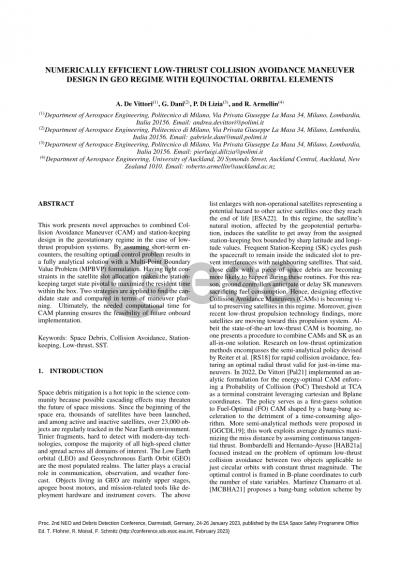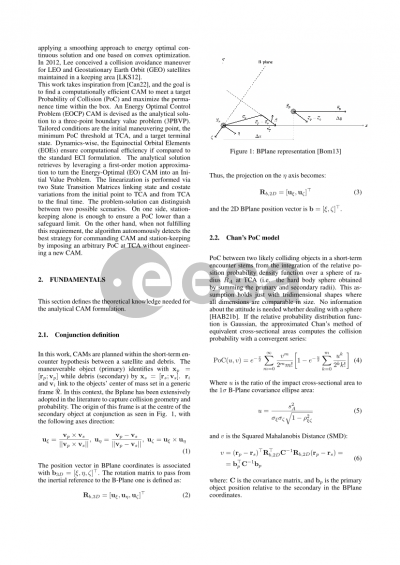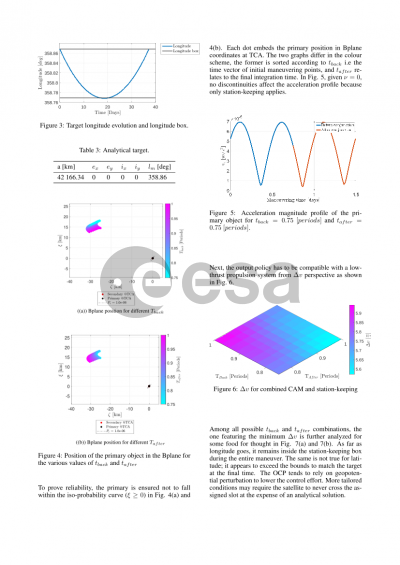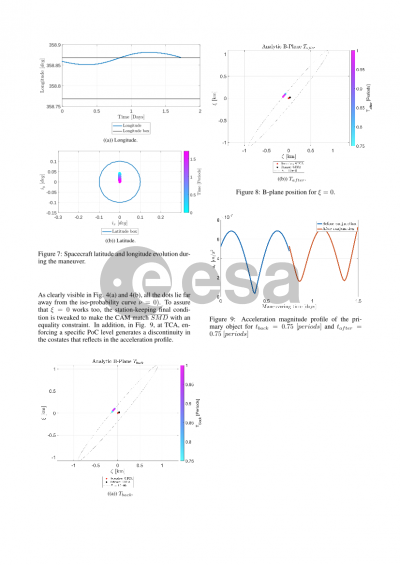Document details

Abstract
Over the last decades, the number of satellites in space has grown at an unrelenting pace. For active and inactive satellites, over 23,000 objects are regularly tracked in the Near-Earth environment. Furthermore, millions of tiny fragments resulting from space travel and human activity are impossible to detect. As time goes on, the once empty orbital ring is becoming a dumping ground; eventually, space debris will limit access to space in any way.
The low Earth orbital (LEO) and geosynchronous Earth orbit (GEO) are the two most crowded orbital zones. The latter plays a key role in communication, observation and weather forecast purposes. In this regime, the satellite's natural motion, affected by the geopotential perturbation, drifts the satellite out of the allocated station-keeping box bounded by sharp latitude and longitude values. Frequent Station-Keeping (SK) cycles force the spacecraft to stay within the indicated slot to avoid interferences with neighbouring satellites. However, during one of these routines, close encounters with a piece of space debris may occur. For this reason, satellite controllers bring forward or postpone the SK maneuver at the expense of fuel consumption. Hence, planning effective Collision Avoidance Maneuvers (CAMs) is becoming a crucial task for space missions' success and for extending their lifetime. Moreover, given recent findings in low thrust propulsion technology, more satellite manufacturers will rely on this propulsion system for future missions. Albeit being the state-of-the-art low thrust CAM thorough, no one presents a procedure to embed CAMs and SK in a single optimized maneuver.
In this work, the aim is to find a computational efficient CAM able to meet a target Probability of Collision (PoC) and maximize the resident time within the box. An Energy Optimal Control Problem (EOCP) CAM planning is devised as the analytical solution to the three-point boundary value problem. Tailored conditions are the initial maneuvering point, the minimum PoC threshold at TCA and a target terminal state. Dynamics-wise, the Equinoctial Orbital Elements (EOEs) ensure computational efficiency when compared to the traditional ECI formulation, and it makes the fuel optimal adaption straightforward through a smoothing approach. The analytical solution retrieves by leveraging a first-order motion approximation to turn the EOCP into an Initial Value Problem. The linearization is performed via two State Transition Matrices linking state and costate variations from the initial point to TCA and from TCA to the final time. The problem-solution can distinguish between two possible scenarios. On one side, station-keeping alone is enough to ensure a PoC lower than a safeguard limit. On the other, when not fulfilling this requirement, the algorithm autonomously identifies the best strategy for commanding CAM and station-keeping by imposing an arbitrary PoC at TCA without solving a new EOCP. Results indicate a limited computational burden for the EOCP solution and an effective, although more timely, bang-bang firing policy.
Preview











